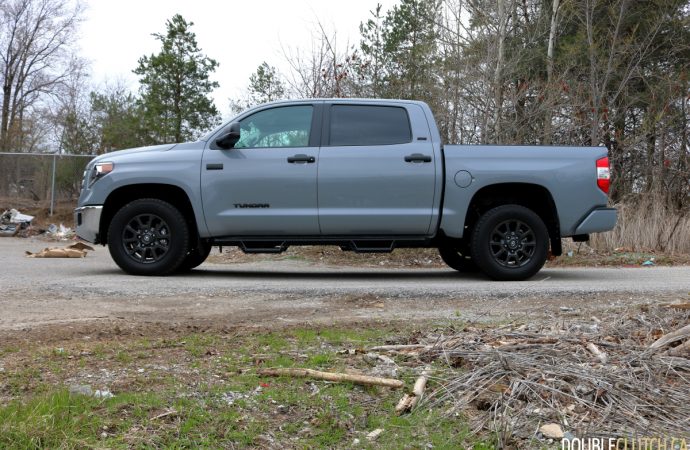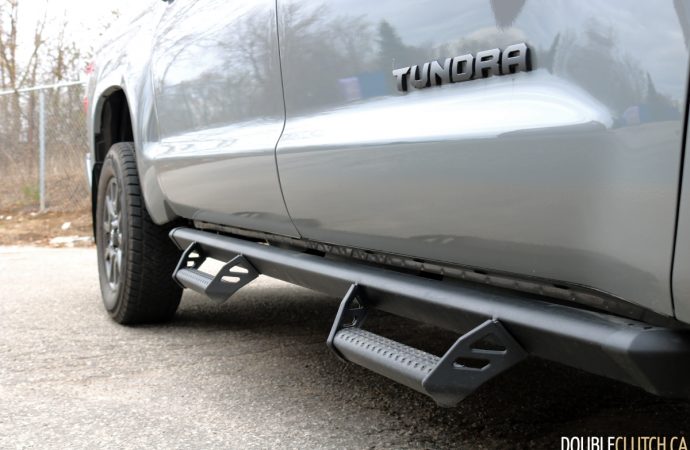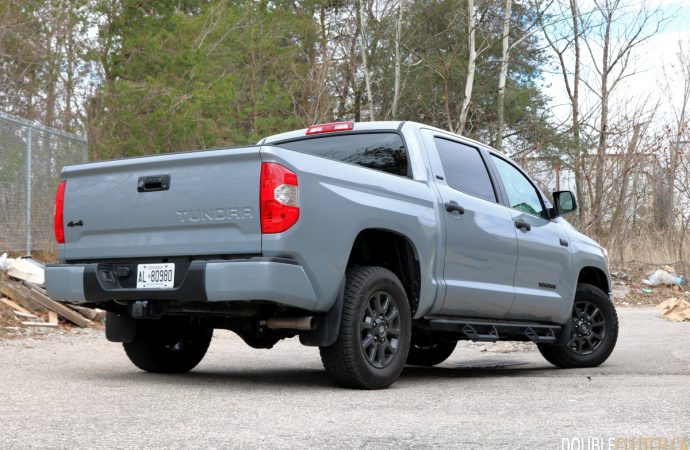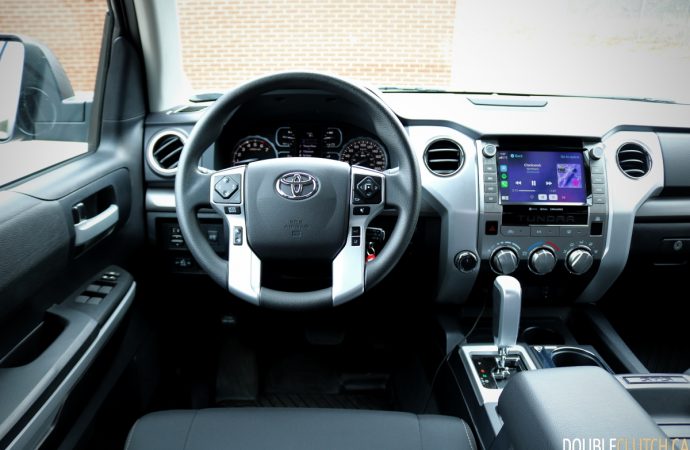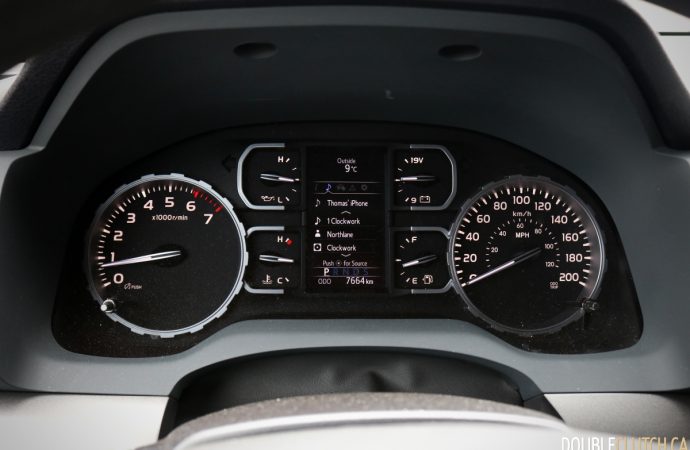Look at any internet comment section on any article about trucks and a common theme will arise – Complaints about the latest crop of trucks being too complex, too expensive and little more than luxury vehicles. If these commenters looked around a bit, they’d find that the simple, hard-working half-ton truck they desire already exists, and has existed since George W. Bush’s second term. The 2021 Toyota Tundra SR5 Trail continues in the marketplace as a no-nonsense truck.
The Trail trim is new on the Tundra for 2021 and it commands a $3,640 premium over the basic CrewMax SR5. What does the Trail package add? Some minor appearance tweaks, and that’s about it. Toyota blacked-out the emblems, gave the seats a bespoke upholstery treatment, added dark grey TRD wheels, raided the parts bin for the grille insert off the 1794 trim Tundra and bolted on a set of bro-dozer side steps.
To ensure further distinction, the Trail package only comes in two colours, a sort of shiny primer that Toyota calls Cement and a dark green that Toyota calls Army Green. While it adds up to a mostly attractive look, we would like to see the Bilstein shocks from the TRD Off Road model on the Trail, particularly as the TRD Off Road model is only $10 more and adds dual-zone climate control, a moonroof, LED headlamps, all-terrain tires and the aforementioned Bilstein shocks, among other equipment.
On the outside, the Tundra is a handsome and traditional truck. It’s a blocky silhouette with squared-off wheel arches, a large upright grille and purposeful, minimalist character lines. The faux scoop above the grille may not be to everyone’s taste, but the Tundra offers a look that’s more agreeable overall than polarizing recent designs from Chevrolet and Nissan.
One fantastic perk of the CrewMax crew cab body style is that the rear window rolls all the way down, facilitating through-loading of long items and giving occupants the option for a real open-air feel. Hopefully the next Tundra retains the roll-down rear window.
On the inside, the Tundra is basic but very functional and very user-friendly. The gauge cluster features physical dials for voltage, coolant temperature, fuel level and oil pressure, important metrics for anyone looking to do real truck work. The knobs and buttons on the centre console are Mega Blocks-levels of oversized, perfect for operating while wearing gloves. Furthermore, no secondary functions are hidden in sub-menus, there’s just a button for everything.
From killing advanced driver assist nannies to activating tow/haul mode to tuning through radio stations, everything is intuitive and purposeful. As expected for a crew cab truck, interior space is absolutely cavernous, although the lack of storage under the rear seat is a bit of a disappointment. What isn’t disappointing is the sheer quantity of cupholders. There are three in the centre console, two bottle holders in each of the doors and two more in the rear armrest for a grand total of thirteen.
As for technology, the Tundra keeps things simple with a small 4.2-inch screen in the gauge cluster and an eight-inch touchscreen that’s largely easy to use. While some functions like the stereo equalizer are bizarrely buried in drop-down menus, there are enough redundant controls to make general navigation of the infotainment system a doddle. As for the stereo, it’s an eight-speaker unit that does its job of being audible with all windows open, but little more. There’s heaps of harmonic distortion, but it still beats most base-level audio systems in other trucks.
Powering the Tundra is Toyota’s familiar 3UR-FE 5.7-litre naturally-aspirated V8 making 381 horsepower and 401 lb-ft. of torque. Hitched to a six-speed automatic gearbox, it’s a very smooth unit that offers plenty of linear power while remaining hushed on the highway. What’s more, it still produces slow-breathing, unlaboured, old-school V8 truck sounds at idle, a wonderful familiarity for anyone looking to upgrade from an older truck.
Put your foot down, and the V8 bellows like a living creature, reminding the driver that a good V8 offers incredible emotional attachment. Sure, some competitors make more power and more torque out of boosted V6s, but at the end of the day, is that what you really want? Curiously, throttle tip-in on the Tundra is rather aggressive, requiring a careful right foot to not leave black streaks of rubber across rain-slicked intersections.
As for the six-speed automatic gearbox, it’s definitely not the most modern unit but it doesn’t suffer from the gear hunting that Ford’s 10-speed does. Granted, that’s mostly because it literally only has 6/10ths of the gears to choose from. Simplicity can sometimes be a good thing. Unfortunately, this simplicity also translates to rather poor fuel economy.
Over a week of mixed driving, we averaged 16.4 L/100km which is about bang-on with the government’s rating of 16.3 L/100km combined. It’s a wallet-busting reminder of how advanced efficiency features like cylinder deactivation, stop-start and more than six gears really have moved the game on in the past fifteen years or so.
The 2021 Toyota Tundra SR5 Trail may be a dinosaur, but it’s a dinosaur in all the right ways. It carries itself with such an admirable honest sense of simplicity that it serves as an antidote to ticked-up Cowboy Cadillacs, a reminder of what a truck really ought to be. It can’t match the interior of a Ram, the powertrain lineup of Chevrolet and GMC or the work-focused feature set of an F-150, but it doesn’t need to. It just needs to do its job of carrying on for absolute ages, towing, hauling, off-roading and doing the stuff a truck is meant to do.

